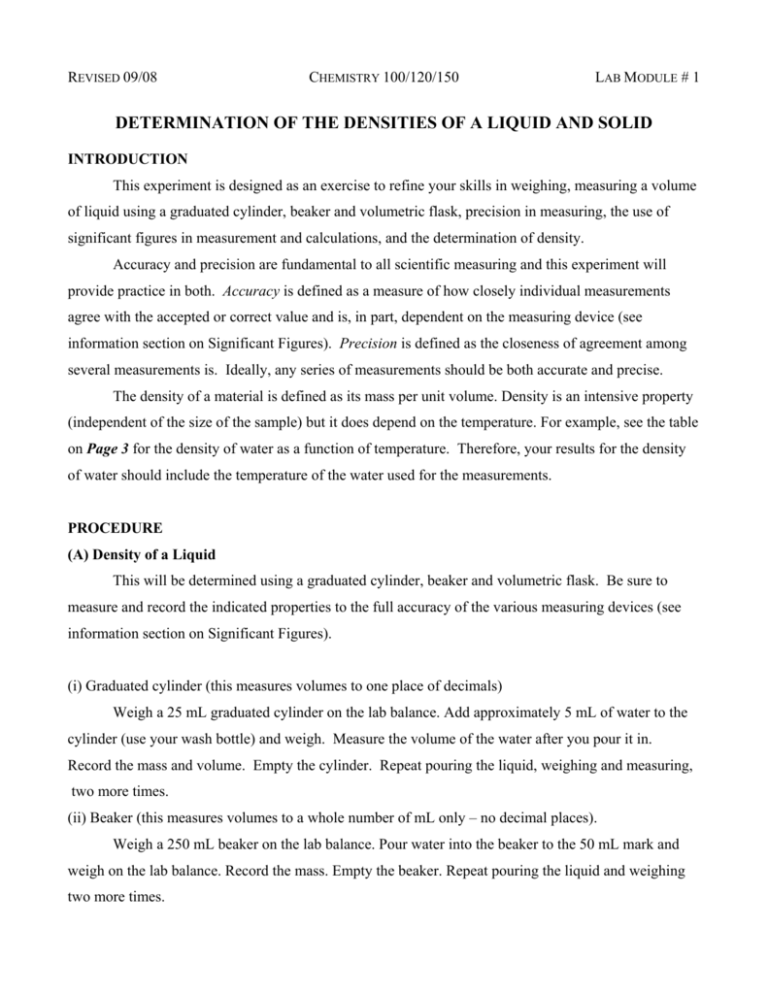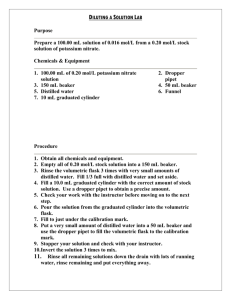DETERMINATION OF THE DENSITIES OF A LIQUID AND SOLID
advertisement

REVISED 09/08 CHEMISTRY 100/120/150 LAB MODULE # 1 DETERMINATION OF THE DENSITIES OF A LIQUID AND SOLID INTRODUCTION This experiment is designed as an exercise to refine your skills in weighing, measuring a volume of liquid using a graduated cylinder, beaker and volumetric flask, precision in measuring, the use of significant figures in measurement and calculations, and the determination of density. Accuracy and precision are fundamental to all scientific measuring and this experiment will provide practice in both. Accuracy is defined as a measure of how closely individual measurements agree with the accepted or correct value and is, in part, dependent on the measuring device (see information section on Significant Figures). Precision is defined as the closeness of agreement among several measurements is. Ideally, any series of measurements should be both accurate and precise. The density of a material is defined as its mass per unit volume. Density is an intensive property (independent of the size of the sample) but it does depend on the temperature. For example, see the table on Page 3 for the density of water as a function of temperature. Therefore, your results for the density of water should include the temperature of the water used for the measurements. PROCEDURE (A) Density of a Liquid This will be determined using a graduated cylinder, beaker and volumetric flask. Be sure to measure and record the indicated properties to the full accuracy of the various measuring devices (see information section on Significant Figures). (i) Graduated cylinder (this measures volumes to one place of decimals) Weigh a 25 mL graduated cylinder on the lab balance. Add approximately 5 mL of water to the cylinder (use your wash bottle) and weigh. Measure the volume of the water after you pour it in. Record the mass and volume. Empty the cylinder. Repeat pouring the liquid, weighing and measuring, two more times. (ii) Beaker (this measures volumes to a whole number of mL only – no decimal places). Weigh a 250 mL beaker on the lab balance. Pour water into the beaker to the 50 mL mark and weigh on the lab balance. Record the mass. Empty the beaker. Repeat pouring the liquid and weighing two more times. Chemistry 150 – Module # 1 – Determination of the Densities of a Liquid and Solid Page 2 (iii) Volumetric flask (this measures a volume to two places of decimals) Weigh a 50 mL volumetric flask on the lab balance. Fill the volumetric flask to the mark on the neck with water. Weigh the flask containing the water. Record the mass. Empty the flask. Repeat pouring the water and weighing two more times. (iv) Record the temperature of the water used. Of (i), (ii) and (iii). Calculate the density of water for each of these. Which vessel that you used produced the most precise sets of measurements? Explain. Which was the most accurate vessel that you used? Explain (see table of densities on last page, and estimate the density if your temperature is between the temperatures given). (B) Density of a Solid Measure the dimensions of the small metal rod provided and weigh the rod on the analytical balance. Take the 25 mL graduated cylinder and pour 15 mL of water in it. Carefully place the rod in the water and record the volume of the water and rod. Find the volume of the solid by subtracting the volume of the water from the volume of the water and solid. Be sure to measure and record all dimensions, weights and volumes to the full accuracy of the measuring devices. Calculate the density of the rod in two ways i.e., using the same mass but the volume measured in the two different ways described above. (a) its volume calculated from its dimensions, and (b) its volume measured by the displacement of the water. Compare the density of the solid obtained both ways. Which do you think is more accurate? Explain. Chemistry 150 – Module # 1 – Determination of the Densities of a Liquid and Solid Page 3 The Density of Water at Various Temperatures (CRC Handbook of Chemistry and Physics) Temperature in oC Density in g/mL 15.0 0.999099 15.5 0.999023 16.0 0.998943 16.5 0.998860 17.0 0.998774 17.5 0.998686 18.0 0.998595 18.5 0.998501 19.0 0.998405 19.5 0.998305 20.0 0.998203 20.5 0.998099 21.0 0.997992 21.5 0.997882 22.0 0.997770 22.5 0.997655 23.0 0.997538 24.0 0.997296 24.5 0.997171 REVISED 05/07 CHEMISTRY 100/120/150/265 SIGNIFICANT FIGURES SIGNIFICANT FIGURES Many operations in the chemistry laboratory involve measurements of some kind. Examples include weighing a compound, measuring the volume of a liquid etc. The number of figures recorded for a measured quantity must reflect the precision with which the measurement has been made. Therefore, a degree of certainty can be attributed to a reported value. All the figures reported must be significant; the value must provide as much usable information as is possible but must also avoid misinformation. By employing the correct number of significant figures, the accuracy of the apparatus will be indicated. Consider the recorded mass of an object to be 12.346 g. There are 5 significant figures with the last digit representing a degree of uncertainty. In this case, this result was weighed to the nearest thousandth (0.001 g) of a gram. This means that the last digit has been estimated and the exact mass is between 12.3455 and 12.3465 g. Significant figures refer to those digits we know with certainty plus the first doubtful or estimated digit. Leading zeros in a number are not significant and trailing zeros are significant only if the number contains a decimal point. Examples: 0.0001234 has 4 significant figures 0.00012340 has 5 significant figures 600 has 1 significant figure but if written as 6.00×102, it has 3 significant figures. If one measures 250 mL to the nearest millilitre, it is more informative to write this volume as 0.250 L or 2.50×102 mL; making all three digits significant. Calculations must also be reported with the correct number of significant figures required to indicate the precision of the experiment. Integers, such as stoichiometric ratios, and other “whole numbers” have infinite significant figures. EXAMPLES OF USE OF SIGNIFICANT FIGURE PLACES AFTER THE DECIMAL THAT ARE SIGNIFICANT EXAMPLE Volumetric Flask Volumetric Pipet Buret Analytical Balance (1st year) 2 2 2 3 50.00 mL 5.00 mL 23.28 mL 12.362 g Analytical Balance (other) Lab Balance Accurate (long) Thermometer Regular Thermometer Graduated Cylinder pH Meter Beaker Erlenmeyer Flask 4 1 2 1 1 2 0 0 14.4821 g 5.1 g 12.36° C 25.2 ° C 23.4 mL 8.32 50 mL 200 mL










